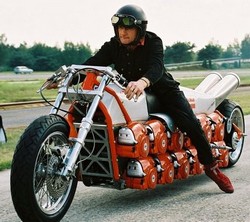Two questions:
1. Does anyone know if any metal parts of the fuel system (including the inside of the tank) have a coating on them that will inhibit the corrosive effects of Ethanol that remains stagnant? My Yamaha outboard boat motor (carbureted) does not and as such, ethanol is a known problem if the boat is not used regularly, and/or the carb bowls drained after each use.
This seems to be one those internet factoids that, after being repeated often enough is taken as being a being true, but... What exactly about ethanol is so corrosive to metal? I would suggest, nothing. Ethanol does negatively effect rubber and certain plastic parts, but metal?
The main reason that carbs get all gummed up after storage is the fuel evaporates and leaves behind a hard varnish that plugs up jets and such. But this always happened with non-oxygenated fuels too. I suppose that the ethanol laden fuel sitting in the float bowls for a long time would effect the gaskets and seals, but that would be true if the bike was just sitting or being used and fresh ethanol was constantly being introduced.
The idea that ethanol is hygroscopic and therefore absorbed H2O will corrode the metal fuel tank isn't quite right either. Consider that any water that is absorbed in the fuel would have been in the fuel tank anyway (the alcohol didn't make it come in there) but if the fuel was straight gas with no alcohol the water would be in a separate state. And we
know that water is highly corrosive to metals. Having alcohol in the fuel actually allows the water present to be absorbed and then burned (vaporized) along with the fuel. Yeah that doesn't help get rid of it when the tank is being stored, but neither does straight gas.
2. "...Of course since naturally aspirated engines do not have variable compression ratios (unlike turbo or super charged engines)..."
Fred.... huh? I thought by definition, C/R was the ratio of the volume of the combustion chamber at BDC compared to TDC.
Yup, that formula is correct... for a normally aspirated engine. Forced induction (turbo or blower) jams several PSI of air (and fuel) into the cylinder during the intake stroke, thereby increasing the
effective compression ratio. IOW, the intake is already pre-compressed, so the total compression ratio is greater.
Modern turbochargers are really a thing of technical beauty and elegance. Yes, just strapping an intake compressor onto an engine not designed for the increased power it can generate can easily cause problems. But when a powerplant has been designed for the added torque of a high compression turbo blower it is the best way to achieve power when needed and still maintain reasonable economy when the power is not needed.
As I've mentioned in the past, I have been rather a big fan of SAAB autos for quite some time. Their design engineers were some of the first to truly embrace turbocharged forced induction as a design tenant, and they had pretty much perfected them before their recent demise. It was too bad that GM purchased a controlling share and then proceeded to run the company into the ground with traditional bad American business management practices. But the good news is that the marque has been resurrected and will live on in Trolhatten, Sweden. Whether we ever see any new SAABs here in the USA again is up in the air right now.
The limiting factor on how high you can pre-compress the intake air (called the boost) for most modern turbo or supercharged engines is the octane value of the fuel. If the boost is too high it will cause detonation and the engine will fragment. Inter-coolers have become commonplace on turbocharged cars and trucks to offset the heat generated during the pre-compression and reduce the likelihood of detonation. They are basically just an air to air heat exchanger (radiator) that the intake passes through after the blower compresses it but before induction.
Even with engines that have dimensionally low compression cylinders, any decent turbo can create too much boost. How much is too much is critical to engine health and entirely dependent on the fuel octane in the tank. Turbo engines generally have a knock sensor to sense the onset of detonation and will automatically reduce the boost levels when knocking is sensed. That allows you to run lower grades of fuel without destroying your engine, albeit at lower power levels due to the reduced boost.
There are some new design ideas that would use direct ethanol injection, substituting it for a fraction of the regular gasoline fuel injection, just during high boost situations as a means to allow even higher boost levels without knocking or detonation. Of course just running a higher percentage ethanol fuel would have the same effect but with negative consequences on fuel economy when you were not on high boost.





















































